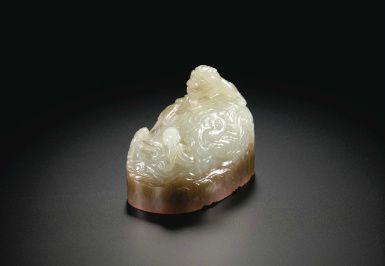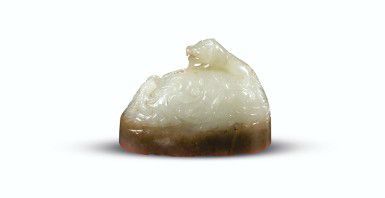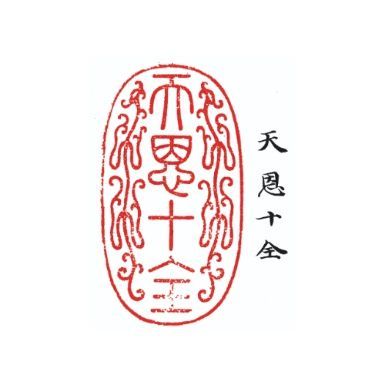An Imperial Celadon And Brown Jade 'Tian'en Shiquan' Oval Seal. Qing Dynasty, Qianlong Period
An Imperial Celadon and Brown Jade 'Tian'en Shiquan' Oval Seal. Qing Dynasty, Qianlong Period - Photo Sotheby's
of oval section, the translucent stone of pale celadon and caramel-brown tones, carved in relief with a powerful chilong writhing among swiftly incised scrolling clouds, its head turned back towards a smaller chilong clambering through the mist, the underside crisply carved vertically with four characters in seal script reading Tian'en shiquan ('Ten Victories Thanks to Heaven's Blessing'), flanked by a pair of stylised chilong; 8.6 cm., 3 3/8 in. Estimation:  8,000,000 - 12,000,000 HKD . Lot. Vendu 16,340,000 HKD
8,000,000 - 12,000,000 HKD . Lot. Vendu 16,340,000 HKD
NOTE DE CATALOGUE
The Qianlong 'Tianen Shiquan' Seal
Guo Fuxiang
About ten years ago, I published a research monograph titled Ming Qing dihou baoxi ('Ming and Qing Royal Seals'). In this book I reached the conclusion that Qianlong seals were distinct in that they displayed a tendency to 'record events and note successes.' I also wrote, 'The Qianlong emperor, during his reign, commemorated every important national event and imperial-family occurrence by carving a seal.(...) Until his death, he continuously remade seals. If we line up all the Qianlong emperor’s seals according to their dates of manufacture, we would see at a glance the important national events and imperial-family happenings that occurred during the Qianlong reign.' This feature of Qianlong seals means that the great historical events of the Qianlong period (1736–1795) were important background factors in the cultural significance of Qianlong seals, and hence are key to understanding Qianlong seals. The present Tianen shiquan seal being auctioned by Sotheby’s Hong Kong is just such a seal noting important successes.
This seal is made of greyish-white jade and has a knob of two hornless dragons. The inscription consists of four raised characters, Tianen shiquan, in the seal script. The upper half of the seal is greyish-white jade, and the lower half is tan-coloured Qianlong-period Han style jade. This seal is explicitly described in Qianlong bao sou ('Catalogue of Qianlong Seals'), housed in the Beijing Palace Museum, and it matches this description in all particulars, including the size of the seal and the style and layout of the seal characters. Hence, we can affirm that this seal is a genuine article of the Qianlong period.
To accurately understand this seal, it is necessary to clarify the historical background and origin of the term shiquan appearing in the inscription. On 7th October 1792, the Qianlong emperor, while preparing for the fall hunt at the Emperor’s hunting grounds at the Rehe Mountain Summer Retreat, received a report from General-in-Chief Fu Kang’an, who had subdued the Gurkhas, and accepted the surrender of the Gurkha king Rana Bahadur Shah. This wonderful news greatly pleased the eighty-two-year-old Emperor, and he immediately allowed the King to pledge fealty and commanded the general to lead his troops back to the capital. On the same day, the Emperor wrote the poem Kuoerka Latena Baduer qianshi huizui qixiang, yin xu qi qing, ming kaixuan banshi zhishi ('The Gurkha Rana
Bahadur Shah Came in Embassy, Repented His Disloyalty, and Asked to Surrender. Hence, I Allowed Him to Supplicate and Commanded That the Army Return in Triumph and Withdraw and That Events Be Recorded'). The last verse of the poem reads, 'We even succeeded in the ten complete military achievements [shiquan da wuyang].' This seems like a summary of the many wars the emperor engaged in with foreign powers and in the borderlands. The next day the emperor, still in high spirits, wrote Shiquan ji ('Note on the Ten Campaigns; literally, Note on the Ten Accomplishments'). In this work, he recounted the wars that he engaged in while on the throne to secure the borderlands and strengthen his rule, and he called the ten most significant of these victories shiquan wugong ('Ten Complete Military Accomplishments'). As the Emperor's recalls it 'these accomplishments were: Twice pacifying the Dzungars, settling the Muslim tribes [of the Northwest], twice sweeping up the Jinchuan region, pacifying Taiwan, subduing Burma and Annan (one campaign each), and now twice accepting the submission of the Gurkhas- a total of ten campaigns.' This is the origin of shiquan wugong, which the Qianlong emperor often happily referred to and repeatedly brought up in his later years. In the view of the Emperor, these wars were not wars of aggression, but rather were unavoidable and regrettable military deployments, for the Emperor, achieving peace in the borderlands and pacifying the affected peoples by means of these ten victories had no ordinary significance. 'Now, having completed the ten military campaigns, all providing abundant protection, we have ten complete military achievements to glorify. Going forward, I only wish, with the country secure and foreign lands pacified, to enjoy the blessings of peace along with the officials and people of the Empire.'
Though shiquan may at first have been the Qianlong emperor’s summary of his historical military achievements in opening up the borderlands, soon thereafter he began calling himself Shiquan laoren (The Old Man with Ten Accomplishments), but this was not intended just to comment his military achievements. In fact when the emperor commanded that the artisans make the Shiquan laoren zhi bao (Seal of the Old Man with Ten Accomplishments), he again wrote an essay, this one titled Shiquan laoren zhi bao shuo ('An Explanation of the Seal of the Old Man with Ten Accomplishments'), in which he bestowed additional meaning on the term shiquan: 'Having written Shiquan ji, I then selected a Hetian jade stone and had it inscribed with the characters Shiquan laoren zhi bao, and I explained that while shiquan was originally intended to commemorate military accomplishments, Shiquan laoren zhi bao meant more than this. What do I mean? Military accomplishments are only one of the duties [zhi] of a ruler. Happily relying on Heaven’s aid and prudently endeavouring to complete a given state of affairs, the ruler does not increase the land tax, and tax relief augments fourfold; nor does he exact corvée labor from the people, and the people harvest a great bounty. I have, perhaps, merely avoided the criticism of engaging in senseless wars. As for the ten accomplishments [shiquan] of the old man, this state of affairs is still not complete [quan], for the job of the ruler is not limited to military accomplishments. Zhu Xi said, 'A day on the throne is a day of carrying out imperial duties [guan]. A day of being unable to carry out imperial duties is a day of not being worthy of the throne.' What does Zhu Xi mean by 'imperial duties' [guan]? None other than the duties [zhi] of a ruler. One cannot even list all the duties of a ruler. How can one say that the ruler fulfils all his duties? Since the ruler can never completely fulfil all his duties, is not Shiquan laoren zhi bao [previously translated: 'Seal of the Old Man with Ten Accomplishments'; but which can also be here translated: 'Seal of the Completely Fulfiled Old Man'] self-deception and boasting, and does this not increase the shame? The old man’s complete fulfilment in fact aspires to a greater hope, meaning, that I not persist in my own way and rely on Heaven’s aid to effect it. The ten complete military campaigns have in fact benefited from Heaven’s aid. Well, do the ten campaigns completely fulfil my duties as ruler, and can I perhaps count on Heaven’s aid here too? Now, the man who proceeds a hundred miles looks at 90 miles as incomplete. I now have three more years before I can retire from the throne and regard myself as having fulfiled my duties as ruler. I have yet to go the full distance, and yet these three years seem like three decades. For this reason, when I reached seventy, I linked this milestone with You ri zizi ['Still Diligent Every Day'], as an encouragement, and when I reached 80, I linked this new milestone with Zi qiang bu xi [Self-strengthening Never Ceases], as an inspiration. This may or may not be persisting in my own way. These next three years, do I dare to be lax in encouraging myself to work diligently and respect Heaven’s love of the people? By reverently waiting for Heaven’s gift, perhaps I will attain the condition of complete fulfilment, but in the meantime, three years hence really seems as distant as three decades. How I long for this good fortune! How I anticipate! How I desire to keep my guard up!
Well, what is this excellence, this complete fulfilment, that the Qianlong emperor aspired to? From his own words, we can infer that the Emperor, at this time, thought that he had realised all his ideals except for bequeathing the throne on to his successor after 60 years on the throne and becoming the Emperor Emeritus. Only at that juncture would the Emperor feel that all his long-held ideals were realised and that his life was complete. Hence, the Emperor eagerly looked forwarded to retiring and bequeathing the throne, and on occasion revealed his anticipation. For example, the emperor wrote: 'I reckon that after next year it will be 1796, when I will retire and pass on the throne. I find that I am still agile in spirit, and I hope that I may be granted my long-standing wish. If this is possible, then I will indeed be a completely fulfiled person [shiquan zhi ren]. With Heaven’s favour, I will be the first emperor to be so blessed. For this reason, on 9th November 1795, while preparing for the imperial succession ceremony, he instructed the Grand Secretary of the Grand Secretariat, 'After I retire, make a seal that reads Taishang huangdi zhi bao [Seal of the Emperor Emeritus] from the no. 1 Xi ('happiness') jade seal, and make a jade album on which is inscribed my Shiquan laoren zhi bao shuo [An Explanation of the Seal of the Old Man with Ten Accomplishments, or An Explanation of the Seal of the Completely Fulfiled Old Man'] and let this be the Emperor Emeritus’s treasured keepsake to show forth the prosperity of this reign.' The emperor’s use of this essay in a jade album resembling a title-conferring plaque clearly shows the strong connection in the Emperor’s mind between complete fulfilment (shiquan) and his status as Emperor Emeritus. It is precisely for this reason that the Qianlong Emperor Emeritus, after the imperial succession ceremony in the first year of the Jiaqing reign (1796), could finally announce, 'On the first day of this year, I conferred the imperial seal and retired from government. I am now the first completely fulfiled person in all the ages.' And again, 'On the first of this year before the full court, I conferred the imperial seal and assumed the title of Emperor Emeritus, happily becoming a completely fulfiled person for all the ages.' In Qianlong’s mind, becoming a completely fulfiled person is the result of satisfying numerous conditions. He emphasised that he could attain this station in life only with Heaven’s aid and providence, only with Heaven’s favour (tianen). This is therefore the thought expressed by the seal Tianen shiquan ('Complete Fulfillment with Heaven’s Favour'; or alternatively, 'Ten Military Achievements with Heaven’s favour').
To summarize the historical facts above, we see that the term shiquan has two levels of meaning. On one level, it summarizes historical achievements in opening up the borderlands. On another level, it comments on the emperor’s personal career. The present seal was definitely made after the Qianlong emperor bequeathed the throne to the Jiaqing emperor, since the other two seals in this set are Taishang huangdi (Emperor Emeritus) and Jichou wufu (Jizi’s nine categories and the five happinesses)—an indication that this important seal was carved after the emperor became Emperor Emeritus. The purpose of this seal is quite clear: the Emperor sought to advertise his merits and virtues by way of recalling and summarizing his splendid life. The seal thus reflects the emperor’s state of mind at a late point in his life. His use of Tianen shiquan as the inscription for a seal no doubt springs from a sense of accomplishment and a sense of gratitude for Heaven’s aid.
As mentioned, this seal is one of a set of three seals. It was used as the leading seal in estampages. The other two seals in the set were the Taishang huangdi and Jichou wufu seals. The seals in this set are large compared to those in other seal sets of the Emperor Emeritus. One special feature of the present seal is that the characters Tianen shiquan are arranged in a column from top to bottom, and to occupy the empty space thereby created, the printing surface has a dragon on either side of the inscription. The other two seals in this set were sold at auction in November 2002 by Huachen Auctions in Beijing. The present seal and the two trailing seals are all made of Han type jade, but there is a clear difference. A reasonable explanation for this difference is that the two trailing seals were probably remade from a pair of old seals, and to make a set of three, a similar piece of jade was selected and carved.

/https%3A%2F%2Fprofilepics.canalblog.com%2Fprofilepics%2F1%2F0%2F100183.jpg)
/https%3A%2F%2Fstorage.canalblog.com%2F03%2F02%2F119589%2F96711876_o.jpg)
/https%3A%2F%2Fstorage.canalblog.com%2F11%2F31%2F119589%2F94773502_o.jpg)
/https%3A%2F%2Fstorage.canalblog.com%2F20%2F83%2F119589%2F94772815_o.jpg)
/https%3A%2F%2Fstorage.canalblog.com%2F26%2F72%2F119589%2F75604929_o.jpg)
/https%3A%2F%2Fstorage.canalblog.com%2F59%2F60%2F119589%2F26458628_o.jpg)








/http%3A%2F%2Fstorage.canalblog.com%2F98%2F98%2F119589%2F129097971_o.jpg)
/http%3A%2F%2Fstorage.canalblog.com%2F93%2F75%2F119589%2F128489120_o.jpg)
/http%3A%2F%2Fstorage.canalblog.com%2F09%2F29%2F119589%2F128488304_o.jpg)
/http%3A%2F%2Fstorage.canalblog.com%2F62%2F18%2F119589%2F128488091_o.jpg)